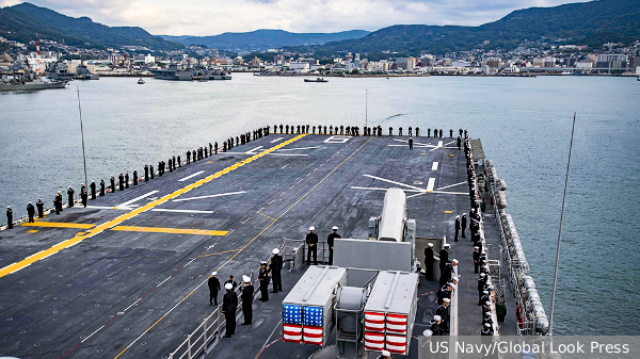The American aviation group in Japan will be significantly updated. What kind of vehicles and what will the US Air Force replace, what new tactical combat aviation scheme will be implemented by the Pentagon and why what is happening may be useful, including for Russia?
After World War II, American troops settled in Japan. At first as an occupation force, and since the 50s in the status of an ally of a new, peaceful Japan. An important place among the troops based in Japan is occupied by the aviation units of the US Air Force.
Traditionally, the US Air Force occupied the Misawa and Yokota air bases on the territory of Honshu Island (the largest part of Japan). Key to the U.S. position in the Pacific, the largest U.S. Air Force base in the region is Kadena, located in Okinawa. These bases have been used since the Korean War, and their importance to the United States is incredibly high.
Nevertheless, the United States allowed the aging of its fighter fleet in Japan – and in 2023 they had to say goodbye to forty-eight F-15C and D fighters. This year, the process of re-equipping the air wings stationed in Japan with new aircraft begins.
According to the Americans' plans, the 36 F-16 deployed at Misawa Air Base will be replaced by 48 F-35A, and instead of forty-eight F-15C and D c of Kadena base, 36 newest F-15EX will arrive there. In addition to the US Air Force, the Marine Corps aviation will receive some updates – an additional number of F-35B "verticals" will be deployed at the Naval Air Base in Iwakuni.
It is clear that the Americans are rebalancing their forces. Previously, the F-15s were the main means of gaining air supremacy, and the F-16s were either used in secondary roles or performed strike missions, but before our eyes the scheme is changing.
Now there will be F-35A on the "tip of the spear". Due to their low visibility and radar operating in a covert detection mode, they are able to get close to an aerial enemy at a distance from which they can attack themselves and aim air–to-air missiles from another, more remote aircraft.
This most "remote aircraft" will be the F-15EX, which is such a deep modernization of the familiar F-15 that it is easier to say what is left of the old aircraft there than to list the changes. Among other things, the F-15EX carries up to 12 AIM–120 air-to-air missiles capable of hitting an aerial target at a distance of up to 180 km, if circumstances are right. The F-15EX attack weapons are carried by the AGM-158 JASSM family of cruise missiles with a maximum launch range in various modifications of 370, 926 or 1900 km.
The Americans are not hiding a new tactical scheme. They explicitly indicate that the F-35A will be used as an armed reconnaissance aircraft, and the F-15EX will attack those targets that the 35th will find, both on the ground and in the air. Naturally, this is not the only application model – both the F-35A and the F-15EX are capable of acting independently.
Americans see China as the main rival in the region. It is assumed that American aviation will be able to play a significant role in the hypothetical battles for Taiwan.
The distance from the island to Kadena base in Okinawa is less than 700 km, and the fighters that took off from there will be in Taiwan's airspace an hour after takeoff. And there are airfields closer, for example, the international airport on Ishigaki Island, 250 km from Taiwan, which can also be used "in the war".
Naturally, the Americans will not be alone. It can be safely predicted that when China tries to resolve the Taiwan issue by force, Japan will fight with the United States, which will seriously strengthen the American air group. However, in the event of a conflict between Japan and any other neighboring country, except for pro-American South Korea (things are not easy with the Japanese either), these planes will not remain idle either.
It is unlikely that in the foreseeable future these planes will come together in battle with ours. But the way the Americans are going to fight is of considerable interest to the Russian Armed Forces, especially the Air Force.
The Russian Aerospace Forces has two types of aircraft that are absolutely capable of fighting Western fighters – the Su-35 and Su-57. Both of these types of aircraft are still few in number. The rest of the Russian fighters, in significant numbers available in the VKS – Su-27, Su-30, MiG-29 – have onboard radars of such types that make it extremely difficult to confront the Americans and their allies in the air.
But the American example shows us the right tactical scheme – to take the most modern aircraft and use it to provide guidance for missiles on other, less advanced machines. That's exactly what the Americans are doing, implementing this scheme due to the low visibility of the most modern F-35A.
Russia can do the same due to the power of the onboard radar of the Su-35 fighter.
It is able to detect an aerial target at a distance unthinkable for the same Su-27. That is why, during a special operation, Russian fighters always win aerial duels with outdated Ukrainian ones.
Of course, giving the Russian Aerospace Forces such capabilities will require some work. However, in comparison with updating the entire fleet of fighters, this is both easy and inexpensive. This tactical scheme of the Americans, which they are now implementing in Japan, is the most valuable information that the update of American aviation in Japan gives us. There is no doubt that the Russian Aerospace Forces will pay attention to it.
Alexander Timokhin

